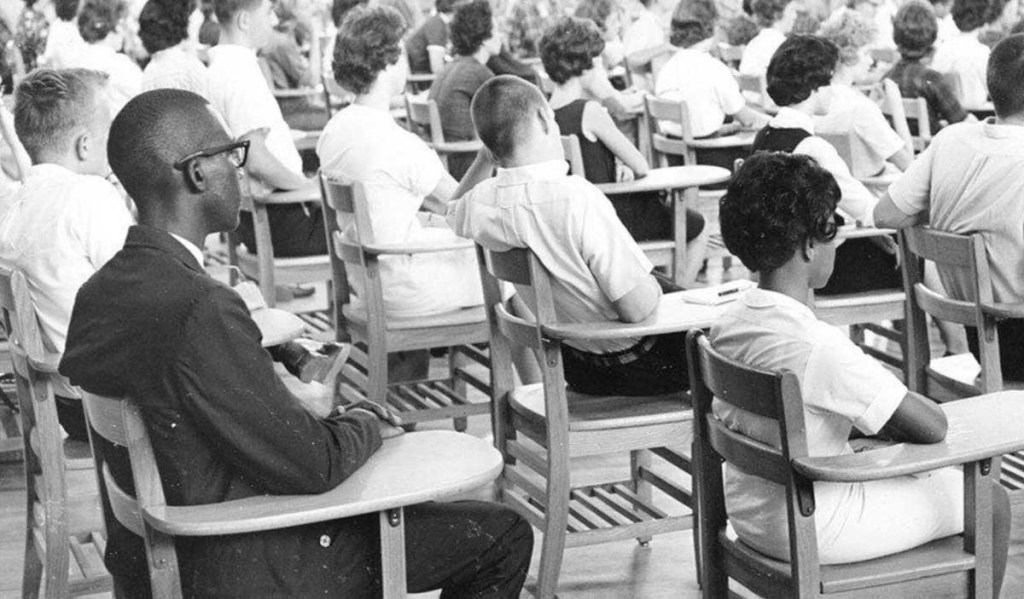Explainer: Rearview look at affirmative action and Black college enrollment
Published 12:00 am Thursday, July 13, 2023

- Robert Pierce Jr. and Drewnell Thomas paved the way for integration at what was then Valdosta State College (now Valdosta State University) in 1963 as the first Black students on the campus. Submitted photo
ATLANTA — While many public colleges and universities had already jettisoned affirmative action programs, the U.S. Supreme Court’s June 29 ruling against factoring race in college admissions, leaves private, more selective, universities having to find new ways to meet diversity goals.
“I have watched states ban the use of race as a factor in admission to public universities and have seen the declines — in some cases precipitous — of underrepresented minority students at those institutions,” said Gregory Fenves, president of Emory University, the largest private institution in Georgia.
Fenves said he is worried about the longterm impact of the SCOTUS decision, adding, “American higher education has been the greatest engine for opportunity our nation has ever known. The repercussions of today’s decision will be felt over time, in the businesses, public service roles and communities where our graduates work and live.”
Fenves said the university’s current admissions process evaluates each applicant as an individual — looking at their talents and accomplishments, and their characteristics and experiences that have prepared them to contribute to the university’s educational community.
Emory University — which has accepted a record number of Black (13%) and Latinx (11%) students as part of the Class of 2025 — joined 14 other universities around the country in signing on to an amicus curiae brief in the Supreme Court’s cases (“Students for Fair Admissions Inc. v. President & Fellows of Harvard College and Students for Fair Admissions Inc v. the University of North Carolina”) that struck down affirmative action — a practice that has been used since the 1960s — in college admissions.
University of Alabama Professor of Law Bryan Fair, a UCLA graduate, has written several publications on the topic of affirmative action, including the book “Notes of a Racial Caste Baby: Colorblindness and the End of Affirmative Action.” He argues that affirmative action is necessary due to the setback Blacks have experienced as a result of slavery and its lingering affects.
“The gist of the book was an unapologetic unequivocal defense of remedial affirmative action policy, describing it really as a response to historic racial preference preferences for whites in the United States,” Fair said. “And that as a corrective measure, remedial affirmative action was fully within the Constitution and consistent with equal protection.”
In the Aug. 1, 2022, amicus curiae brief, the universities said a diverse student body strengthens the educational experience for all students.
“Diversity fosters a more robust spirit of free inquiry and encourages dialogue that sparks new insights. Diversity encourages students to question their own assumptions, to test received truths, and to appreciate the complexity of the modern world,” the universities stated in the brief.
The conservative super majority on the Supreme Court, however, agreed with plaintiffs who argued that admission policies that consider race and diversity as part of the admissions process, ultimately discriminate against other races such as Asian American or white applicants.
Georgia colleges move from affirmative action in 2001
In 2001, the U.S. Court of Appeals for the 11th Circuit upheld a ruling against the University of Georgia in “Johnson v. Board of Regents of Univ. of Georgia.”
The case was brought by three women who were denied admission into UGA in 1999. At the time, UGA added a fixed numerical bonus to the admissions scores of non-white applicants and male students.
The court found that the admission process violated the Equal Protection Clause of the Fourteenth Amendment. The court said that to pass the constitutionality test for an affirmative action program, the university needed to present both a “compelling state interest” and prove the program was “narrowly tailored to meet that interest,” which the court said the university failed to present.
Public schools in Georgia, and neighboring states in the 11th Circuit, including Alabama, subsequently stopped using race as a factor in admissions.
“At all 26 University System of Georgia institutions, race or ethnicity is not a determining factor in admissions. USG follows the law with regards to the admission of students,” according to a June 29 emailed statement from University System of Georgia, composed of 26 higher education institutions.
States report enrollment data after removing race factors in college admissions
California was the first state to constitutionally ban affirmative action in college admissions in 1996, through Proposition 209, which amended the state constitution to prohibit race conscious measures in college admissions.
Texas, Washington, Florida, Michigan, Nebraska, Arizona, New Hampshire, Oklahoma and Idaho have also formally done so.
Nearly a dozen California universities signed on to an amicus curiae brief in the Supreme Court case in support of allowing colleges to consider race in admissions.
After the 1996 vote in California, freshmen enrollees from underrepresented minority groups dropped dropped by 50% or more at University of California’s most selective campuses.
The brief indicates that prior to the vote, Black students at UCLA made up 7.13% of the freshman class in 1995, and only 3.43% in 1998; Latinx students were 21.58% of the freshman class in 1995 and only 10.45% in 1998.
While African American students were 6.32% of the freshman class at UC Berkley in 1995, they were 3.37% in 1998; Latinx students were 15.57% of the freshman class in 1995 and 7.28% in 1998, despite the state’s African American and Latinx public high school students representing 7.5% and 31.0%, respectively.
The brief argued that despite UC’s numerous race neutral measures to increase diversity during the past 25 years —costing $500 million in outreach — and despite significant improvements over that period, UC still struggles “to enroll students who can offer underrepresented perspectives.”
“Given that a significant majority of undergraduate classes offered at UC Berkeley have fewer than 50 students, simple mathematics dictate that African American and Native American students will often be the only student of their race in their courses, “ the California brief stated. “As this Court has recognized, that can lead to feelings of racial isolation and concerns about being treated as a ‘token diverse voice — and it reduces all students’ opportunity to engage with diverse viewpoints.”
However, a December 2021 amici curiae brief signed onto by 14 state attorneys general in the Supreme Court case argued that affirmative action enhances “tokenism.”
Oklahoma Attorney General John O’Connor led the amici curiae brief signed onto by 13 other state attorneys general— including Alabama and Georgia— in support of banning affirmative action in admissions.
Oklahoma voters banned consideration of race in college admissions in 2012.
The brief indicated that there has been no long-term severe decline in minority admissions at the University of Oklahoma since prohibiting race in admissions.
University of Oklahoma’s Institutional Reporting and Research reports that by 2019, enrollment of Black freshmen at its Norman campus had dropped from 5.1% of the class to 3.7%, and enrollment of Native American freshmen had dropped from 3.8% to 3.0%.
Oklahoma argued that states with similar Black populations as Oklahoma that do factor race in admissions “are no less diverse than comparable universities in states that still permit such discrimination, including UNC.”
Colleges such as University of Mass.-Amherst and University of Minn.-Twin Cities are only within 1 percentage point ahead in Black enrollment compared to Oklahoma.
Black graduation rates increase in diverse environments
Research by The Journal of Blacks in Higher Education reports the highest graduation rates of Black students at the nation’s highest-ranked colleges and universities that have the strongest commitments to race-sensitive admissions.
Based on 2005 data, Harvard, Princeton, Brown, Stanford, Yale, Duke and Wake Forest were among universities with with an 85% or more Black student graduation rate.
“Academically selective institutions are almost always strongly committed to affirmative action in admissions, yet at the same time they tend to deliver a high Black student graduation rate,” the report stated. “The fact that almost all entering Black students at Harvard, Amherst, Princeton, and several other highly ranked colleges and universities go on to earn their diplomas shows that African Americans do compete successfully at our nation’s most prestigious institutions of higher learning.”
The research suggests that colleges (and states) where there are more diverse populations, culture and programs help boost retention and Black graduation rates.
Historically Black colleges and universities, overall, have seen increases in enrollment in recent years.
Alabama has 14 HBCUs, the most of any state in the country. Less than half of the state’s non-HBCU colleges have a Black student enrollment of more than 26%, or equal to the state’s Black population.
According to the United Negro College Fund, though HBCUs make up only 3 percent of the country’s colleges and universities, they enroll 10% of all Black students in the country and produce almost 20% of all African American graduates.
However, Black Americans sill fall behind, overall, in educational attainment.
As of 2021, 34% of Black Americans 25-34 years of age had an associates degree or higher, below the national average of 45.7%, according to research by the Lumina Foundation, an advocacy organization for higher education. Nearly 66% of Asian of Pacific Islanders and just over 50% of white Americans between ages 25-34 had at least an associates degree.
Lack of support for affirmative action
A Pew Research Center poll of more than 5,079 adults from March 27 to April 2, 2023, showed that half of those polled do not support using race as a factor in college admissions.
Forty-seven percent said they approve of colleges and universities considering prospective students’ racial and ethnic backgrounds when making admissions decisions, compared with 29% who disapprove and 24% who indicated “not sure.”
Among Hispanic Americans, 39% approve and 39% disapprove, as both white and Asian Americans are more likely to disapprove of colleges factoring in race and ethnic backgrounds. Fifty-seven percent of white adults and 52% of Asian adults polled said they disapprove.
Opinions are more closely divided on whether students’ educational experiences are better or worse at schools that consider the race and ethnicity of applicants, with nearly identical shares saying that students’ experiences are better (27%) and worse (26%), according to the Pew Research poll.
The 6-3 Supreme Court against affirmative action in college admissions appears to align with poll numbers.
The majority opinion from the justices states that the Equal Protection Clause of the Constitution applies “without regard to any differences of race, of color, or of nationality” and has universal application. For “[t]he guarantee of equal protection cannot mean one thing when applied to one individual and something else when applied to a person of another color,” the Supreme Court opinion states.
Fair said the ruling could shut down talks of reparations which would offer some assistance to the descendants of enslaved people as a acknowledgement of the negative affects of slavery in America on Black people.
“This (Supreme Court) opinion creates a narrative that remedial affirmative action is wrong. That addressing historic discrimination in the nation by using race as a corrective measure is wrong,” Fair said. “An opinion like this basically says that using race in a government policy is presumptively impermissible.”


